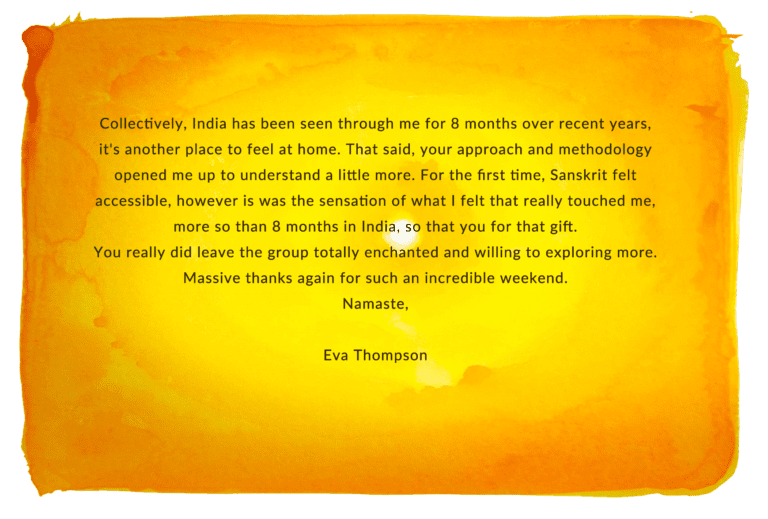Yoga Sūtra 1.2: yogaḥ cittavṛttinirodhaḥ
A multitude of yoga teachers’ websites and yoga studios display their interpretation of Patañjali’s Yoga Sūtra 1.2 as “yoga is the stilling of the fluctuations of the mind”. This translation is not only incorrect but it does not carry any of the depth held within the Sanskrit words. Patañjali was a master of yoga who chose three words to elicit within us the vast potential that yoga has to offer. To varying degrees we have all had an experience of stilling a busy mind; is this really the ultimate goal of yoga?
If we make the stilling of the mind our goal, we assume that our thoughts get in the way of our spiritual awakening and this sets up a dynamic for us to change, improve or even battle against our minds. If our mind is busy then we hope or desire for a different experience, one where our thoughts are still. A belief in a perceived possibility of a better experience also perpetuates thought patterns such as: “When I have achieved x, then I will be able to experience y” which keeps us in a cycle of movement away from the present moment and away from a trust in the validity, worth and even necessity of what we are experiencing right now.
A closer look at each of the Sanskrit words in this sūtra will show us the shortcomings of this English translation and will help to make clear what Patañjali was really pointing to. We will start with citta, whose scope in Sanskrit takes us far beyond the English word ‘mind’. To understand this further we will look at the different words that Patañjali uses for the word mind; manas, buddhi, asmitā and citta, and the particular function to which each word refers.
Manas
The root of manas is man: in the dhātu pātha (recitiation of the roots of the Sanskrit language), the meaning of man is avabodhane = ‘in considering’ and jñāne = ‘in knowing/thinking’
Manas is the Sanskrit word that is most closely aligned with the concept referred to by the English word ‘mind’. The manas gathers information through the senses and interprets, organises and puts actions into place dependent on its conclusions. It is responsible for everyday thoughts that appear to have an important function of keeping a certain order in our life, like sending an invoice, doing the washing up or responding to hunger. The thoughts of the manas are also experienced as the constant chatter that attempts to make sense of the events of our life by creating meaning. The way in which the manas interprets these experiences will determine the way in which it desires to partake in or avoid future experiences.
 Buddhi
Buddhi
The root of buddhi is budh: in the dhātu pātha, the meaning of budh is avagamane = ‘in waking’ or ‘in understanding’ and bodhane = ‘in waking up’
The buddhi is our mind’s capacity to discriminate, observe and judge the thoughts of the manas. It can appear to us in the form
of a clear thought that judges whether the
desires and plans of the manas are beneficial or not, and as a feeling or atmosphere that appears to pervade everything we do. This atmosphere is always present in the background of our minds and determines the way we interact with people and situations, subtly managing our actions and words according to our unconscious and conscious hopes and desires about what we want from a situation.
The buddhi is experienced as a combination of the qualities of rajas, tamas and sattva and these qualities changes over time. A rajasic buddhi encourages thoughts of action and productivity but in excess it can guide the manas with impatience and anger. In its positive orientation a tamasic buddhi favours thoughts that create structure and stability; in excess it can have depressive and jealous tendencies that shapes the thoughts of the manas accordingly. A sattvic buddhi knows exactly when to act and when not in accordance with the natural rhythms of the universe; in excess it creates feelings of superiority.
The buddhi feels as though it has its own light, with the capacity to illuminte the thoughts of the manas. Therefore identifying with the buddhi rather than the manas creates more space in our system as it increases our capacity to witness the thoughts of the manas rather than to be so fused with them that we are at the mercy of their whims and fancies. This spaciousness is comparatively more easeful as it feels as though we have more freedom in the choices that we make. However the danger of identifying with the buddhi is that it creates our ego or feeling of being a separate limited individual, and this sense of separateness is explained by the Sanskrit word asmitā.
 Asmitā
Asmitā
The root of asmitā is as: in the dhātu pātha, the meaning of as is bhuvi = ‘in being’
Asmitā is a joining of the verbal form ‘asmi’ and the suffix ‘tā’. Asmi means ‘I am’ and the suffix ‘tā’ means ‘the quality of’ which in total gives ‘the quality of I am’. This quality creates the feeling we have of being a separate individual and is most often referred to by the word ‘ego’ in English. Patañjali defines this further in Yoga Sūtra 2.6:
dṛg darśana śaktyoḥ ekātmatā iva asmitā ।
This sūtra tells us that the feeling of being a separate self is created by identifying the energy of our true limitless Self with a limited part of creation. Interestingly the words he uses for both the limitless and limited self, respectively dṛg and darśana, both have the same root, dṛś. Dṛś means ‘in seeing’, and by using words that share the same root to describe these opposing forces, Patañjali highlights their fundamental unity; the pair of apparent opposites grow from using the same root. Here, as so often in the sūtras, Patańjali makes an apparent distinction between aspects of creation in order to help clarify a subtle function of the mind, but the underlying unity of these aspects is also easily visible to those who know what to look for.
Patañjali uses the word dṛg, which means ‘the one that sees’, to refer to the limitless Self in order to highlight the quality that the limitless Self has of insight and perception. He uses the word darśana which means ‘that which is seen’ to refer to the limited self which is a concise way of saying that anything that we can see or have a cognisant capacity of is not who we truly are. Our thoughts, emotions and feelings are all things that we can see, and if we believe them to have an independent, inherent truth then we will generate a sense of separateness which Patañjali tells us later is the source of all our misery in this life.
Citta
In order to know what citta refers to, we must first turn to the word cit. The root of the word cit is cit itself which has 3 meanings:
sañjñāne = in knowing
sañcetane = in being aware
smṛtyām = in remembering
The meaning of smṛtyām, ‘in remembering’, does not refer to the capacity of being able to remember lots of things at once, but to the ultimate function of memory which is to remember who we truly are. Likewise the sense of ‘in knowing’ and ‘in being aware’ is of the Self. So cit is the energy of Self-awareness, Self-remembrance and Self-knowing. It is a universal energy which has its own light and is most often translated by the word ‘consciousness’ in English. In the statement “sat-cit-ānanda” made in the Tejobindu Upaniṣad, cit is proclaimed to be a part of our true nature which is usually translated as “truth, consciousness, bliss”.
Citta is cit with the suffix ‘ta’ added to it. If we look at the energetic quality of the suffix ‘ta’ as explained in the Maheśvara Sūtras the ‘ta’ refers to the active force or energy that creates a sense of self. So the citta is the Self cognisant universal energy of the cit brought into an individual form. It has a luminous quality that allows us to be aware of our buddhi, asmitā and manas and which creates the mirage of their inherent independent reality. So we tend to identify with these aspects of our mind, believing ourselves to be them, rather than turning toward the light which allows us to see these aspects of our mind.
 By using the word citta in this sūtra, Patañjali points us toward the mechanism behind the thoughts, and notthe thoughts themselves; whether they are busy or still is irrelevant as this is something that always changes. Patañjali is instead pointing to the space which allows the feeling of the buddhi and asmitā to function, the thoughts of the manas to arise, and to what it is that creates the illusion of their inherent truth and validity.
By using the word citta in this sūtra, Patañjali points us toward the mechanism behind the thoughts, and notthe thoughts themselves; whether they are busy or still is irrelevant as this is something that always changes. Patañjali is instead pointing to the space which allows the feeling of the buddhi and asmitā to function, the thoughts of the manas to arise, and to what it is that creates the illusion of their inherent truth and validity.
Patañjali’s interest in this domain of knowledge rather than in the actual thoughts themselves is emphasised by his use of the word citta twenty-one times throughout the Yoga Sūtras and manas only three. If we do not make the distinction between these two very different aspects of mind we will miss the depth and subtlety of Patañjali’s work.
Vṛitti
The root of vṛtti, vṛt, is fascinating because it not only means ‘in turning’, ‘revolving’ or ‘rolling’, but it means ‘in living’, ‘existing’, ‘being found’, ‘remaining’, and ‘abiding’. So we have opposing forces found within the same root which appears contradictory. However, if we accept that we can look at any situation from the viewpoint of both a limited individual identity and a unitive universal awareness, then we see that both forces can exist simultaneously. From the perspective of the limited self, the world appears to be moving and turning, but from the viewpoint of unitive awareness, everything is still, remaining and existing.
I highlight this point in order to show the ways in which we fix meanings to words and assume that if the meaning of a word is ‘x’, it negates it also meaning everything else, including its opposite. Alive within Sanskrit is the understanding that words do not have independent fixed meanings and a proper understanding of the language will help us to shift our attachment to these meanings. This ultimately frees our perception and allows us to move into a unitive vision of the world.
So, with the awareness that movement carries stillness within it, let us look a little closer at what Patañjali could have meant by his choice of the word vṛtti. An understanding of the Saṁkhyā system of philosophy is assumed throughout the Yoga Sūtras and it is here that movement is defined as something that is generated from sound and which creates form. This movement is an integral step in the process of creation and creates the gross and subtle objects around us.
So vṛttis are movements generated by sound that bring objects, thoughts and emotions into creation. This is another pointer to Patañjali’s interest in the mechanism behind the thoughts and not the thoughts themselves. We cannot suppress these movements because they are a natural part of creation and exist for our inspiration and ultimately to allow us to recognise ourselves in all things.
 Cittavṛtti
Cittavṛtti
If we then look to the meaning of citta vṛtti which is a compound formation meaning ‘the vṛttis of the citta’ , then we have something like: the movements (that contain stillness) that are generated from sound, that are pre-thought, that are found within the part of an individual that is in constant remembrance of itself. Or, in other words, there is a part of ourselves that is already in full remembrance of itself, and it is in this place that the impulses to generate thought are created.
Patañjali is pointing to a very subtle place of awareness here which is something that the English language struggles to convey succinctly.
 Nirodha is a joining of the prefix ‘ni’ and the root ‘rudh’. The prefix ‘ni’ carries the meaning of ‘into’, or ‘within’ and in the root ‘rudh’ is given as āvaraṇa in the dhātu pātha which means ‘in covering’ and ‘in protecting’; so within nirodha are the qualities of being both inside and outside any given form. Anything of this nature creates a natural level of restraint because created objects are made from the substance that is within them and is held in place by the substance that covers them. Another by-product of that which is found both within and without us is that it stills the natural processes of contraction and expansion and confines energy into a form. This is why nirodha is often translated to mean ‘restraining’ or ‘stilling’, but these English words carry a strength and even a violence that is not found in the Sanskrit word.
Nirodha is a joining of the prefix ‘ni’ and the root ‘rudh’. The prefix ‘ni’ carries the meaning of ‘into’, or ‘within’ and in the root ‘rudh’ is given as āvaraṇa in the dhātu pātha which means ‘in covering’ and ‘in protecting’; so within nirodha are the qualities of being both inside and outside any given form. Anything of this nature creates a natural level of restraint because created objects are made from the substance that is within them and is held in place by the substance that covers them. Another by-product of that which is found both within and without us is that it stills the natural processes of contraction and expansion and confines energy into a form. This is why nirodha is often translated to mean ‘restraining’ or ‘stilling’, but these English words carry a strength and even a violence that is not found in the Sanskrit word.
So ‘citta vṛtti nirodha’ is asking us to find that which is both within and covering the vṛttis of the citta: that which holds the knowing of who we truly are and that holds the capacity for thoughts to evolve and to be as they are. Yoga is a seeing of the quality and nature of this, and a resting without manipulation of this vision. With this vision, we will still act if necessary, we will still cause motion in the world, thoughts will still appear and creation, growth and movement will still occur all around us. However, there will no longer be a separation between us and the world around us, and our vision will be that which is known as ‘yoga’.
© Lucy Crisfield















